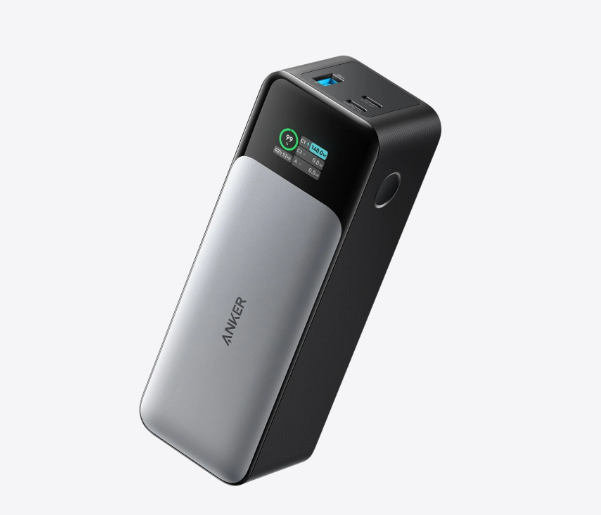
Power Bank Charging Speed: What Should You Know?
No one enjoys running out of battery while on the go. This is where power banks come to the rescue by providing a reliable source of power for your devices. Understanding power bank charging speed is vital because it determines how quickly you can (re)charge your devices. This blog will help you uncover the crucial aspects of power bank charging speed, from the latest fast charging technologies to selecting the optimal power bank for your needs.
Why Charging Speed Matters for Power Banks
Charging speed is a critical aspect of any power bank because it impacts how quickly you can get your device back to full power. Faster charging means less downtime and more convenience—two critical aspects, especially when you are on the move. Modern power banks, such as those from Anker, come equipped with advanced features that make charging faster and more efficient. Instead of waiting hours to get a decent charge, fast charging capabilities can give your device a substantial boost in a fraction of the time.
Moreover, an efficient charging speed is essential for maximizing the utility of multiple devices. If you carry a smartphone, tablet, and laptop, you’ll appreciate a power bank that can deliver power to each device without long delays. Keeping your devices operational is crucial whether you’re traveling, attending meetings, or simply out and about.
Key Factors That Affect Power Bank Charging Speed
Battery Capacity and Output Rating
Battery capacity, measured in milliampere-hours (mAh), directly impacts how much charge the power bank can store. A higher capacity typically allows multiple charges for your devices. Coupled with output rating (measured in watts), these specifications determine how quickly these stored electrons are delivered to your device.
Cable Quality and Type
Not all charging cables are created equal. High-quality, certified cables ensure that the maximum power is transmitted efficiently and safely. Using substandard cables can bottleneck charging speeds and even pose risks to your devices. Types of cables, like USB-C, often support higher top speeds compared to older USB variants.
Device Compatibility and Charging Protocols
Your device’s compatibility with fast-charging protocols like Power Delivery (PD) and Quick Charge (QC) can significantly enhance the speed. If your power bank and device both support these protocols, you can enjoy rapid charging speeds that older technologies can’t provide.
See also: The Evolution of AI Face Swap Technology in Media
Fast Charging Technologies Explained
Power Delivery (PD 3.0 & PD 3.1)
PD technology offers higher power levels and faster charging speeds. PD 3.0 allows up to 100W of power, while PD 3.1 ups the ante to 240W. This makes it ideal for charging larger devices like laptops and rapidly charging smartphones.
Quick Charge and Other Protocols
Qualcomm’s Quick Charge is another popular protocol. It typically offers charging speeds that are significantly higher than standard USB charging. Other protocols, such as Samsung’s Adaptive Fast Charging and Oppo’s VOOC, work similarly to enhance charging speeds.
Role of Smart Charging Chips and Digital Displays
Modern power banks integrate smart charging chips and digital displays for enhanced user experience. These chips optimize the charging cycles, ensuring efficiency and safety. Digital displays provide real-time information at a glance, such as output rating, charge status, and time remaining for a full charge.
How to Check Power Bank Charging Speed in Real Use
Understanding Wattage (Volts x Amps)
To gauge a power bank’s charging capability, you need to understand wattage, which is the product of volts and amps. For instance, a power bank delivering 5V at 3A would give out 15W. Higher wattage generally equates to faster charging times.
Reading Digital Displays and Using Apps (e.g., Anker’s Smart App)
Digital displays on power banks show the current charging status, power output, and sometimes even the time left for a full charge. Apps like Anker’s Smart App provide enhanced insights, helping you monitor and optimize the device’s battery life and performance.
Real-World Examples: Comparing Power Banks
Anker Prime 27,650mAh Power Bank (250W)
This power bank stands out with its 250W multi-device fast charging capability. Equipped with PD 3.1 and dual USB-C ports, it can rejuvenate a MacBook Pro 16” to 50% in just 28 minutes. The Anker app makes operation seamless, providing real-time stats and alerts.
Anker 737 Power Bank (PowerCore 24K)
Anker’s 737 Power Bank leverages 140W Power Delivery 3.1, ideal for fast charging during travel. Its 24,000mAh capacity ensures up to five full charges for an iPhone 13, monitored meticulously via a digital display.

Anker MagGo Power Bank (10K, Slim) and 621 Magnetic Battery
Compact yet powerful, the Anker MagGo Power Bank offers 15W Qi-certified wireless output and a 30W USB-C port. The 621 Magnetic Battery, enhanced by MiniCell technology, is incredibly lightweight and provides reliable magnetic attachment for easy use.
Tips to Optimize Charging Speed
Use High-Speed Certified Cables
Invest in high-speed, certified cables to ensure you’re getting the fastest charge possible. Quality cables not only enhance speed but also safeguard your devices.
Avoid Charging Multiple Devices If Not Needed
While modern power banks can charge multiple devices, the speed may reduce. Focusing on one device at a time ensures quicker charging.
Keep Power Banks Cool and Well-Ventilated
Excess heat can slow down charging speeds and affect battery lifespan. Always keep your power bank cool and well-ventilated to maintain optimal performance.
Conclusion
Understanding the factors influencing power bank charging speeds can significantly enhance your user experience. With advanced technologies like PD 3.1, smart chips, and high-quality cables, the right power bank can quickly become indispensable. Use this guide to navigate your options and keep your devices powered efficiently wherever you go. By selecting the right power bank and employing best practices, you can ensure your devices are always ready when you need them.






